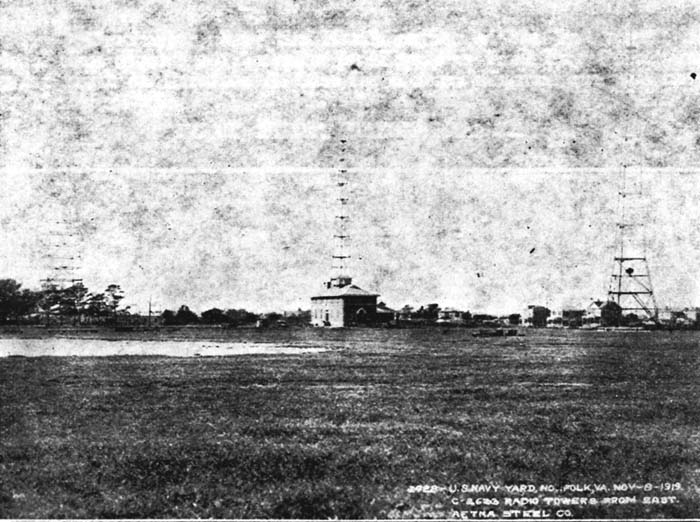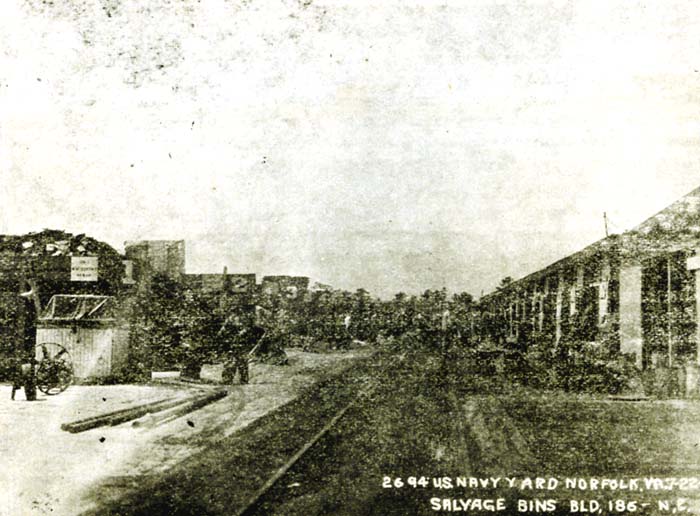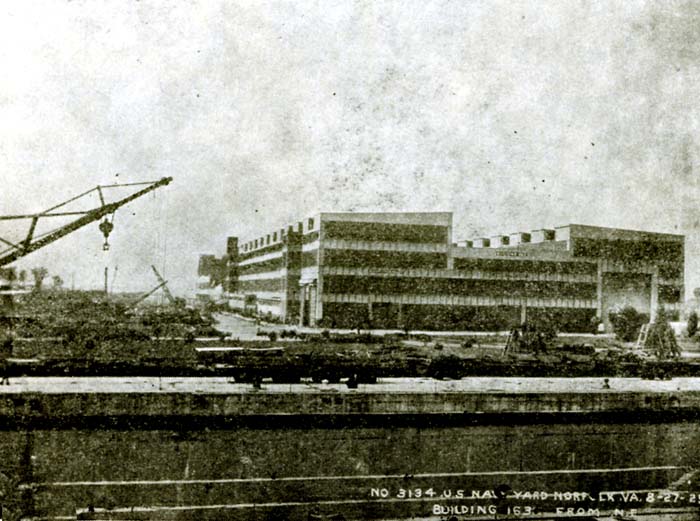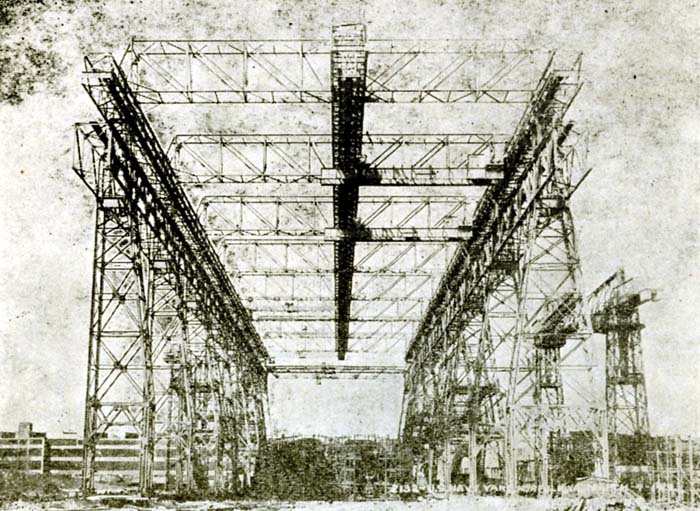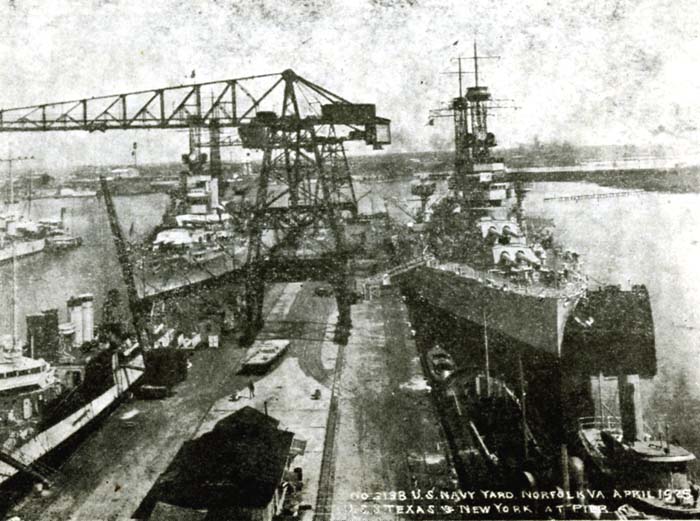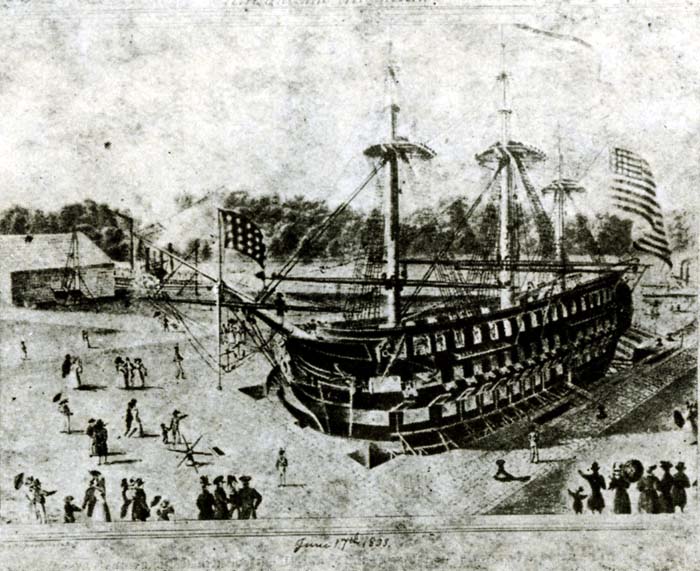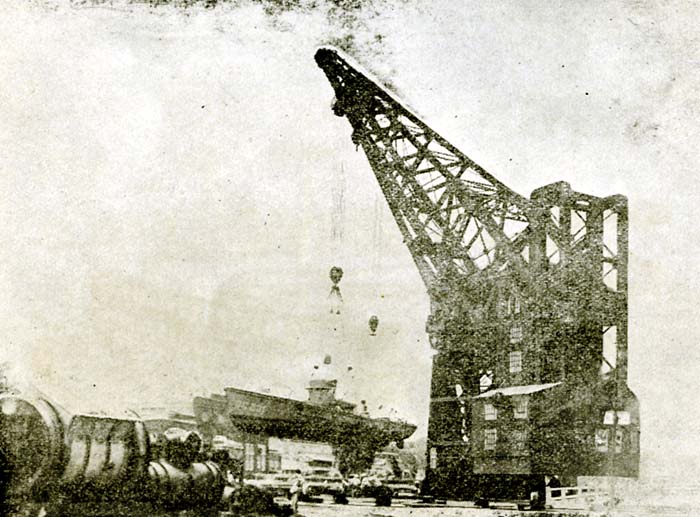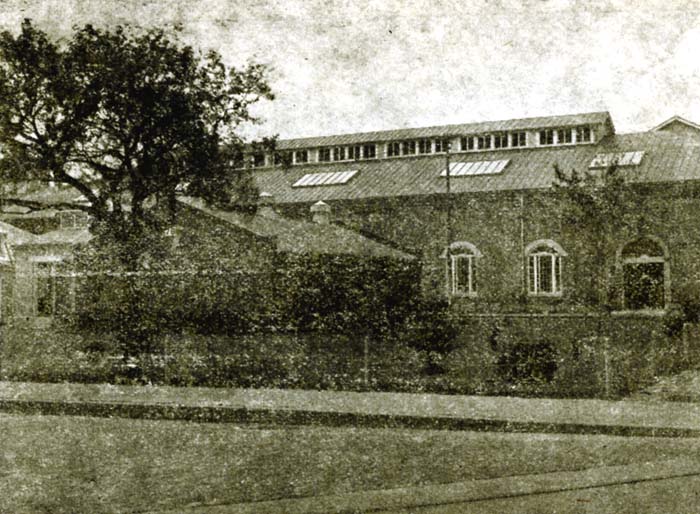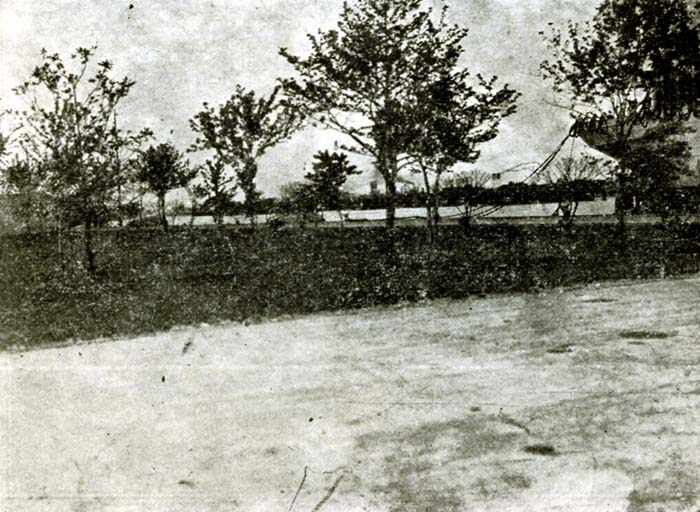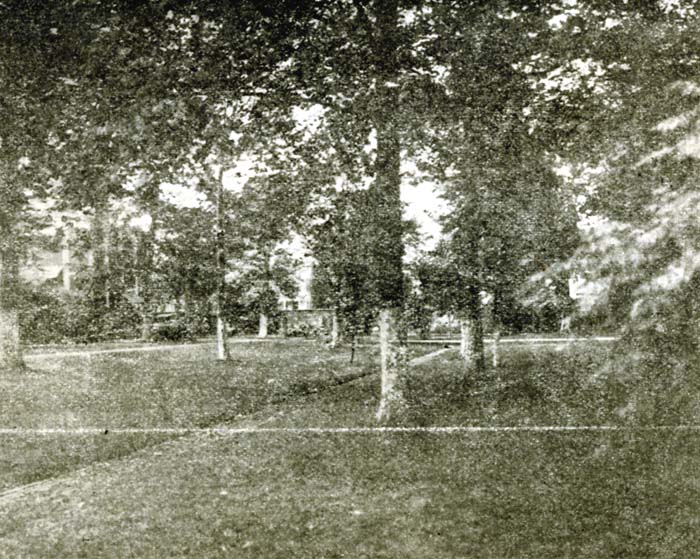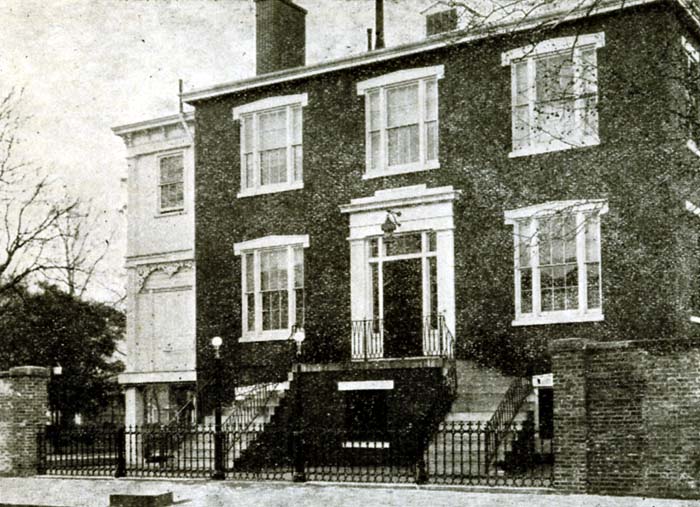GUIDE AND BRIEF HISTORICAL SKETCH
of the
NORFOLK NAVY YARD
1776 - 1926.
Published by the Norfolk Navy Yard, 1928.
The Norfolk Navy Yard was established as a marine repair yard by the English just prior to the begriming of the Revolutionary War and tradition has it that the site was used by them even before that as a careening ground. The locality in which the yard was established and has continued to the present was known as Gosport and for many years until long after the Civil War the local Yard was known as the Gosport Navy Yard. At the outbreak of the Revolutionary War the marine Yard, not yet completed in accordance with the plans of the British, was confiscated together with the adjoining lands belonging to Andrew Sprowle, the British Navy agent, by the Colony of Virginia. It was used by Virginia for the construction and repair of the Virginia Navy during the Revolution as well as for the same work in connection with vessels belonging to the Colonial Congress. The Yard was re-captured by the British in May, 1779, but abandoned after being occupied less than a month when the British decided not to follow up the advantage they had gained by the re-occupation of Norfolk, Portsmouth and vicinity.
When the Virginia Navy was disbanded at the close of the Revolution, and, in fact, until 1794, it is not clear just what status the Yard had. The site was the property of Virginia, but whether or not the Colonial Congress continued to use it is not known. In 1785 a commission authorized by the General Assembly of Virginia to dispose by sale of Certain public lands, decided to retain the marine Yard for the benefit of the Commonwealth. It seems likely, from information available that the Yard as a shipbuilding and repair plant was idle from the close of the Revolution until 1794. In that year Congress aroused by the depredations of the Algerians against our commerce passed an. "Act to provide a naval armament," and the President assigned the duty of carrying out the provisions of the act to the Secretary of War. This, official finding facilities for the purpose already in existence at Gosport, selected this as one of the places for constructing ships authorized in the aforementioned act: and for this purpose the marine Yard at Gosport was loaned by the State of Virginia; to the Federal Government.
The Yard continued to be used by the Federal Government as a loan until June 15, 1801, on which date Governor James Monroe of Virginia, executed a deed granting title and jurisdiction to the United States. This piece of land then purchased cost the United States $12,000 and contained about 16 acres. It has been added to from time to time until the total acreage contained in the Yard at the present time, and which is; the property of the United States, amounts to about 362 acres. Each year since 1801 money has been spent on improving the Yard to make it one of the most up-to-date naval repair, shipbuilding and manufacturing plants in the United States. It has to-day facilities for building, docking and repairing vessels of all classes from the subchaser and fishing smack to the most modern of dreadnaughts and such ocean liners as the Leviathan and Majestic, the channel in Hampton Roads and the Southern Branch of the Elizabeth River being of ample depths to bring such great ships to the local Yard. In its present state of expansion and development the Navy Yard represents an investment of many millions of dollars.
Many of the interesting incidents of the naval history of this country are associated with this Navy Yard. Space forbids a detail recital of them here, but a few of them may be briefly referred to as follows.
The United States Ship CHESAPEAKE built at the Gosport Yard. Originally designed as a 44-gun vessel and completed as a 36-gun vessel. Launched December, 1799.
Commodore Truxton's squadron frequently based on Yard.
Marine guard ordered to Yard in October, 1801; removed, in August, 1804, and again ordered to Yard in November, 1807.
Squadron under Commodore Dale fitted out in Yard in 1801.
Captain Stephen Decatur ordered to Yard to superintend construction of four gunboats. This famous officer remained here as commander of naval forces at Norfolk until November, 1811.
First regularly appointed Commandant, Commodore Samuel Barron, ordered to Yard July 7, 1810.
Keel of line of battle-ship DELAWARE laid in 1817: Launched in 1820.
School for midshipmen established aboard frigate GUERRIERE, in charge of Chaplain David P. Adams in August, 1821.
Dry Dock No. 1, built of Massachusetts granite commenced November, 1827, and completed March 15, 1834, at a total cost of $974,365.65. On June 17, 1833, the DELAWARE was docked in this dock while still uncompleted, being the first national ship to enter a dry dock belonging to the United States.
Yard's activities reduced in summer of 1855, due to epidemic of yellow fever in community.
Gas for lighting Yard and buildings introduced in 1855.
Yard evacuated and burned by Federal forces April 20, 1861.
Construction of Confederate States iron-clad VIRGINIA (Merrimac) 1861-1862.
Yard evacuated and burned by Confederates May 11, 1862.
Dry Dock No. 3 begun in 1903; completed 1908; cost $1,200,000; length 550 ft. 6 in. Dock extended during 1910-11 182 feet in length at cost of $528,956,93.
Keel of U. S. S. TEXAS, second-class battle-ship, laid June 1, 1889; launched June 28, 1892; commissioned August 15, 1895; 6665 tons displacement.
Keel of U. S. S. RALEIGH, protected cruiser, laid December, 1889; launched March 31, 1892; commissioned April 17, 1894.
In 1917, there was commenced and carried to completion the construction of new and modern buildings for steel storage, power plant, machine shop, foundry, paint and oil storage, shipfitter and forge shops, pattern shop galvanizing plant, gas plant and three new dry docks, two of them Shipping Board docks, and the third Dry Dock No. 4, one of the largest docks in the world.
The burning of the Navy Yard by the Federal forces on April 20, 1861, as referred to above, is an interesting story in itself. The following account is taken from an eye-witness of the event.
The Navy Yard at Portsmouth, Va., was fired and abandoned on the night of April 20th, 1861, by the Federal forces, the story of which, and the time of the act are told in history. Happily a few houses only in the city and they of but little value took fire and were burned. On April 22nd, 1861, Captain Robert B. Pegram, then just resigned from the U. S. Navy, and commissioned a Captain in the Virginia Navy, appeared, and acting under orders from the government, assumed command of the Navy Yard and station. On the same date Commodore French Forrest who had also just resigned from the U. S. Navy, and commissioned a Commodore in the Virginia Navy, relieved Captain Pegram of the Command of the yard and station. On the same date, the writer who had been commissioned a Paymaster in the Virginia Navy, and assigned to duty at the Navy Yard, reported and took charge of the provisions and pay departments. His official connection with the yard in this and other capacities continued till the evacuation by the Confederates on May 10th, 1862. The statements contained in this paper may be accepted as facts of which the writer has personal knowledge.
The condition of the Navy Yard at Portsmouth, as it appeared on the 21st & 22nd of April 1861, was melancholy to look upon. On the morning of the 20th of April, 1861, this establishment was the best equipped and in all respects the most complete Navy Yard in the country. On the morning of the 21st of April, it was a mass of ruins. The extensive row of buildings on the north front of the yard, which contained large quantities of manufactured articles, and valuable material, were totally destroyed, together with their contents. The two ship houses "A" and "B" which were immense structures, and in one of which was the line of battle-ship New York on the stocks were also burned, as were also other buildings. The destruction of the stone dry dock was attempted, but was not successful. Twenty-six barrels of powder, a quantity sufficient to have destroyed not only the dry dock, but every building at the south end of the yard, were found distributed in the culvert on its north side, and across the head of the dock. These barrels of powder were connected by a train, which continued on to the inner steps at the bottom of the dock, where it is supposed slow matches were placed for ignition at a pre-arranged moment. Lieutenant M. F. C. Spotswood to whom the discovery was reported early in the morning of the 21st, promptly directed the gates to be opened when the dock was flooded and thus saved from destruction. The destruction of every ship in the yard, except the old frigate United States, was attempted, and in a great part accomplished. The line of battleship Pennsylvania, the frigate Columbia, were burned to their floor heads. The frigate Merrimac was sunk and burned to her copper line, and down through her berth deck, which with the spar and gun decks were also burned. The sloop-of-war Germantown was sunk and burned to her bulwarks on the port side. The sloop-of-war Plymouth, was scuttled and sunk. Line of battle-ships, Delaware and Columbus, were scuttled and sunk at their moorings. Many heavy cannon were spiked, and for the time were rendered useless. Some had their trunions broken off. The total destruction of the Navy Yard at Portsmouth, though attempted, was not accomplished, owing, doubtless to the haste with which the Federals left.
* * * * * *
The Norfolk Navy Yard had always been one of the foremost Navy Yards of the country and has for several decades done a vast amount of the Navy's repair and building work. In addition to its function as repair and shipbuilding plant, the Norfolk Yard manufactures for the Navy's requirements, paint, gas engines, metal furniture, turbine blades and various kinds of gases used for industrial purposes. It is the Navy's principal manufacturing center for most of these products.
The Norfolk Navy Yard has the unusual distinction of having been under five different flags, British, Virginia Colonial, United States, State of Virginia and Confederate States.
GUIDE
The outstanding features of interest in the Navy Yard are given below, with a brief description, in the order in which they are met on the usual itinerary through the Yard.
Entering the Fourth Street Gate, which may now be considered the principal entrance, and following street to the right a short distance the visitor will come to the POWER PLANT, BLDG. NO. 174.
This plant is well equipped and modern in all respects. contains 12—600-H. P. boilers; 3—3, 750-K. W. generators; and air-compressors totaling 20,000 cubic ft. hourly at 100 lbs. pressure. There are no stacks adjoining the building, the draft being obtained by induced and forced draft blowers. The Power Plant may be likened to the industrial heart of the Navy Yard. From it radiate, like arteries, underground cables and pipes to all quarters of the Yard, supplying heat, light and power. A force of skilled mechanics is on duty at all hours of the day and night, as cessation of the plant's activities even for a short period would result in great inconvenience and loss to the Government.Continuing along the same street past the Boat Storage on the right the visitor will see a large, sanitary swimming pool, recently constructed for the use of officers, enlisted men and civilian employees.
Adjacent to the swimming pool is a bungalow-like structure with flower and grass plots about it. This is the Officers' Club-house and may be regarded as the. social center for the officer personnel of the Yard and vicinity.
To the west of this point is the Marine Barracks Reservation. Entering this large area at the Club-house one will have the row of Marine officers' quarters at hand, fronting which are the spacious parade grounds used for military maneuvers and athletic games. From the center of these grounds arise tall radio towers. These towers support the main transmitting antennae of the Yard Radio Station, which is the principal radio station in the Fifth Naval District, and which is remotely controlled from the District Communication Center at the Naval Operating Base, Hampton Roads, Va. To the South of the Radio Station are the main Barracks buildings.
It will be well for the visitor to follow the Parade Grounds until the first Barracks building is passed, then turn to the left and go over to the FOUNDRY, BLDG. NO. 172. This is a roomy structure, well lighted and ventilated. It has a capacity of 36,000 lbs. of steel, 50,000 lbs of iron and 10,000 lbs. of brass per day. The plant is thoroughly equipped with modern apparatus for turning out practically all kinds of castings and other products required in the shipbuilding trades. The smelting and forging operations of the Foundry are interesting processes to witness.
Directly across the street is the MACHINE SHOP, BLDG. NO. 171. This building, also, is very large and excellently lighted for the benefit of the machinists employed therein. Its dimensions are 600 ft. by 120 ft. A mezzanine floor with a width of 60 ft. runs the entire length of the building. This shop is fitted with numerous machines and tools of the most advanced type and is capable of building turbines, reciprocating engines, of effecting practically all repair work pertinent to the machinist's trade and of manufacturing machinery for all types of naval vessels. The important Electric Shop, also, is housed in this building.
To the south of the Machine Shop, just beyond the new athletic field, is the YARD SALVAGE BINS.
In this space are segregated and stored preparatory to reissue or disposal by sale the vast quantities of metal and miscellaneous waste materials turned in by the Yard or outlying units of the district. Hundreds of tons of such materials are normally on hand and none of it is allowed to become a total loss to the Government. Such portion as can not be re-worked and utilized in the Yard shops is put up at public auction, a fair price usually being obtained therefor.
Returning by way of the southeast corner of the Machine Shop and passing the Steel Storage Shed, Bldg. No. 202, which covers four and one-half acres of ground, one comes to the STRUCTURAL SHOP, BLDG. No. 163.
The dimensions of this building are the largest of any in the Navy Yard. It is 698 ft. long by 302 ft. wide, with a height of 82 ft. 10 in. The floor area is 390, 300 sq. ft. In addition to the Shipfitter Shop, this building houses the Plumber Shop, Boiler Shop, Smith Shop and Welding Shop, the majority .of these trades prior to the construction of Bldg. No. 163 being in separate buildings of their own. Passing through this great shop the visitor can see how the fabrication of steel plates, shapes and forgings is carried on in connection with the construction and repair of modern men-of-war and can witness the varied activities and operations of the several shops mentioned.
Emerging from the northeast entrance of the Structural Shop, at the right toward the water appears a big, rectangular, open-work steel structure. This is the BUILDING-WAYS.
These ways were erected in connection with the war-time expansion of the Navy Yard. They were used for the building of the U. S. S. NORTH CAROLINA. When this superdreadnaught was 35 per cent completed and the Yard was well ahead of its schedule of progress of her, the ship was ordered scrapped as a result of the Limitation of Arms Conference. The NORTH CAROLINA was subsequently sold to a contractor, cut into pieces and disposed of by him.
South of the Building-ways and adjacent to the Structural Shop are FITTING-OUT-PIERS 3 AND 4.
These piers usually present the busiest scene in the Navy Yard. To them are moored vessels undergoing repairs and alterations and various types of navel ships can be seen here almost any time from some of the Navy's biggest fighters to tugs and motor boats. This is a good place to stop if one is interested in seeing mechanics in the actual work of maintaining units of the fleet in efficient condition for service.
Proceeding north and toward the water-front, the visitor will reach the first of a series of six dry docks bordering the Southern Branch of the Elizabeth River in this portion of the Yard. The first and greatest of these is DRY DOCK No. 4.
This dock is a remarkable sight to those who have never seen a dry, or graving dock before. It is 1,011 ft. long, 144 ft. wide nd 40 ft. deep. Ground was first broken for this dock on January 8, 1917, and it was completed on April 1, 1919, at a total cost of approximately $4,800,000. Dry Dock No. 4 can handle such vessels as the giant ocean liners LEVIATHAN and MAJESTIC with room to spare. This dock can be filled with water in one hour s time and pumped out in three and one-half hours, the two pumps used for the purpose expelling 112,000 gallons per minute. The long rows of blocks noticed on the bottom of the dock are the keel blocks on which the vessel being docked will rest when the structure is unwatered.
Crossing the caisson of Dock No. 4 one comes to two comparatively small docks, Nos. 7 and 6, which were constructed for the U. S. Shipping Board Emergency Fleet Corporation to care for its local shipping, but subsequently turned over for the use of the Navy. The first watering of these twin docks was made a gala occasion, King Albert and Queen Elizabeth of Belgium, the Crown Prince and a distinguished party from Washington, including the Secretary of State and Secretary of the Navy, being present. Queen Elizabeth pulled the string allowing the water to pour into the dock.
Next in order is Dry Dock No. 3. This structure is 723 ft. in length with a width of 130 ft. It is capable of docking any ship in the Navy. The possession of this dock and Dock No. 4, described above, makes it possible for the Norfolk Navy Yard to dock simultaneously any two of the Navy's biggest ships, a feat which can not be accomplished by any other navy Yard in the country.
A short distance beyond is Dry Dock No. 2. This dock is built of wood and concrete, the sides being in the form of steps leading to the bottom. This dock was begun in 1887 and completed two years later. In spite of its ancient years this old structure is still rendering excellent service in the Yard.
Dry Dock No. 1. Docking of U. S. S. Delaware, 1833.The last dock to be reached, but the first in number and historical significance, is Dry Dock No. 1. This stone dock, which is among the very oldest structures remaining in the Navy Yard, was commenced on December 1, 1827, when John Quincy Adams was President of the United States, and was first opened for service on June 17, 1833, while Andrew Jackson occupied the Presidential chair. On that date the line of battleship Delaware, the first battleship built in the local Yard, which was then known as the Gosport Navy Yard, was docked, this being the first docking of a national ship in a dry dock belonging to the Nation. A large oil painting showing this docking of the Delaware is on exhibition in the Administration Building of the Yard.
In this dock, also, the United States Ship Merrimac was converted into an iron-clad under the name of Virginia, and subsequently became famous through her celebrated battle with the Monitor in Hampton Roads.
Continuing along the North coping of the last mentioned dock, then around a triangular building, the Yard Pay Office, and going north on Renshaw Avenue for a short distance one will have on the right the BOAT SHOP, BLDG. NO. 37.
For those interest in the way the Navy builds its small craft the processes used and skilful work of the boat-builders in this shop will claim attention. The local Yard has been very successful in the building of motor-boats and other craft and a considerable part of the Navy's work along this line is allotted here.
Southward from the Boat Shop and just north of the dry dock area is the PAINT SHOP, BLDG. NO. 62.
The Norfolk Navy Yard is the manufacturing center for paint and certain kindred products used by the country's naval ships, producing approximately 75 per cent, of the to^al amount of such materials used by the Navy. The Paint Shop is well equipped to handle expeditiously the demands made upon it. In the past it has been necessary to work continuous shifts, during which times the monthly output has amounted to between 50,000 and 60,000 gals. of paint and approximately 1,250,000 lbs. of white lead, zinc and other pigments in oil.
Adjacent to the Paint Shop is the gun storage. In this space the visitor may see specimens of the large calibered guns used on the Navy's men-of-war. From this place the guns are lifted by cranes immediately on to the deck of the carrier for transshipment to the West Coast, or other destination.
Proceeding northeast from the Paint Shop and then west on Breese street, the visitor will pass the Saw Mill, Bldg. No. 30, which will well reward an inspection by anyone interested in the working up of lumber into its finished shape and sizes.The second story of the next building to the west, Bldg. No. 31, is utilized as a club for the enlisted men of the Yard and ships at the Yard. This club was recently established as a recreation center for the enlisted personnel. It has a dance hall, stage, gymnasium, pool and billiard tables, store and reading room, with a barber shop and tailor shop immediately accessible. Weekly dances are given for the enlisted men, their families and friends.
The adjoining building in the same direction, No. 32, contains on the upper floor the Yard Drafting Rooms, where a large force of expert draftsman are engage in preparing the numerous plans required by the manifold activities of the Navy Yard.
This brings the visitor to the final building in this row, namely: THE ADMINISTRATION BUILDING, BLDG. NO. 33.
The great mass of the paper work of the Navy Yard is done in this building. The lower floor is occupied by the Supply Department, Shop Superintendent's Office, Post Office and Labor Board. On the upper floor, south end, are the offices of the Commandant, Captain of the Yard and File and Correspondence Section. The Industrial Department takes up the central portion, and the Accounting Office is in the north end.
Turning to the right on Renshaw Avenue, located just south of the Tennis Courts, is the Navy Yard Dispensary, Bldg. No. 68. This houses the Medical Staff of the Yard, who are charged with the health of the officer and enlisted personnel, supervision of the sanitation of the reservation and the furnishing of medical attendance on the families of officers and enlisted men of the community.
Within view of the Dispensary to the east is Wet Basin No. 1, which is utilized primarily to berth naval ships out of commission at the Yard. As a general thing the berthing space afforded by this basin is preempted by vessels of divers types, colliers and other of the larger ships out of commission usually being, assigned to this basin.
Somewhere along the water-front the visitor will doubtless behold a towering steel crane. This is the largest floating appliance of this nature in the Yard. It may possibly be seen in action, always an interesting operation to witness. This crane can lift from the water a fully equipped boat weighing up to 150 tons and deposit it without disturbing anything aboard, so accurate is its mechanism in response to the operator's control.
Proceeding along the north side of Basin No. 1, one will come to a large structure, Bldg. No. 59, now used as the Shipping Division of the Supply Department. This fronts on Warrington Avenue, one of the principal thoroughfares of the Yard.
The next building on Warrington Avenue is the SHEET METAL SHOP, BLDG. NO. 55.
In volume and character of work this is among the most important shops of the Navy Yard. The Norfolk Yard manufactures most of the metal furniture now used instead of wooden furniture on board ships of the Navy, and in this shop can be seen, in addition to the routine sheet metal work of the shop, the fabrication of lockers, tables, bureaus and other such metal accessories, from the raw material to the final spraying of paint on the completed product.
Extending from Warrington Avenue to the water front is what is known as "Bevo" Park, so named from "Bevo", a big St. Bernard dog, the inseparable companion of the Commandant who is responsible for the establishment of the park. This area, formerly covered with debris and waste material left over from the war, was converted almost over-night into an extensive grove of native trees and now constitutes one of the most attractive environments of the Navy Yard, especially to the crews of vessels coming to the Yard after months at sea.
Complimentary reference is often heard from visitors upon the large number of trees, shrubs and flowers to be observed throughout the Yard. By far the greater part of this planting has been effected during the past several years, and in this work of beautification the authorities of the Yard have received the enthusiastic cooperation of the community, a number of municipal, civic and patriotic organizations having taken plots in different parts of the Navy Yard and planted them as memorials to fellow members killed in the war or for other salutary reasons.
The visitor has now arrived at the First Street entrance, the usual exit following a visit to the Navy Yard, and will pass out with a parting view of Trophy Park, its towering trees, and many trophies of historical and traditional interest, with the century- old home of the Commandants appearing at the end of a vista along the margin of the grove.
COMMANDANT'S HOUSE (Quarters "A")
Looking at the modern-appearing house in the above picture, one would not think that this 17-room home of the commandant of the Norfolk Navy Yard is among the oldest dwellings in the good City of Portsmouth, which city, being practically coeval with the Navy Yard, possesses a number of houses which were built in what might be described in these fast moving times as "the years of long ago."
The residence in the picture is known in the phraseology of the Navy Department as "Quarters "A", Navy Yard, Norfolk, Va., notwithstanding the exceedingly obvious fact that it is not in Norfolk at all.
Quarters "A" was built in 1824 as a home for the Command ants of the Navy Yard, and is accordingly over a hundred years old. It appears to have been first occupied by Master Commandant James Renshaw, U. S. N., who was in command of the Yard in that year. Since that date the house has been the temporary home of fifty commandants, or all but twelve of those who have held that assignment since the Navy Yard has been in existence. Among its occupants, therefore, have been officers whose names are famous in the naval annals of America and practically all of the outstanding figures of the Navy have at one time or another brought their ships here for overhaul and repair and at these quarters paid their respects to the Commandant of the station.
THE END.



